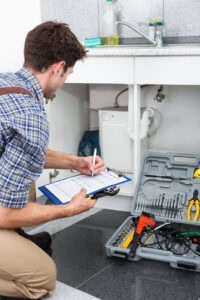 If you’re new to home ownership, you may not be familiar with all of the responsibilities that are now yours. All of those things you used to call the super or management office for now fall in your lap.
If you’re new to home ownership, you may not be familiar with all of the responsibilities that are now yours. All of those things you used to call the super or management office for now fall in your lap.
Here are some items to keep in mind, especially if you got a “great deal” on your home because it needed a little TLC.
Little Drips and Leaks
Plumbing maintenance can by far cause some of the most costly problems if you ignore those little, niggling drips, clogs or strange sounds in the pipes. Leaks and drips under the sink are out of sight, so they often are out of mind. However, a buildup of moisture in a sink cabinet can set the stage for costly mold problems.
If the leak is on an upper level and the moisture seeps into the walls and subfloor, it endangers the structural integrity of the ceiling below. Latex paint has the particular ability to “stretch” and hold moisture. When this happens, you may not notice the damage to the ceiling below until the paint forms a moisture-filled bubble. By this point, drywall, insulation and subfloor will need extensive and expensive repairs.
Better to get the leak looked at right away by a certified plumber.
Roofing
To an untrained eye, a roof may appear perfectly fine, but hail, heavy rain, ice, snow or wind can cause damage to your roof. When left unrepaired, a damaged roof exposes your home to the elements, inviting potential damage. Here are some signed you need an expert roofer to inspect your home:
- Missing shingles: During heavy downpours, strong windstorms or as snow and ice melts and slides off your room, tearing shingles away. While roofing tiles are designed to overlap, offering double protection, when one layer is missing, water can seep underneath and cause damage. Having a few shingles replaced is much less expensive than have to completely replace the deck (the layer of wood under your roof) of your home and completely re-roof it.
- Curling or lifting shingles: A curled shingle or a row of lifted or buckled shingles indicates that you may already have a leak, or the potential for one. Have these shingles replaced immediately and inspect the deck and sub-roof materials for damage.
- Decay and mold: When mold, moss or lichen grows on your roof it’s a sign that areas of the roof are holding water. Treat the growths with a killing agent immediately. Have damaged shingles repaired as soon as possible.
- Damaged flashing and drip edge: Flashing refers to the metal or vinyl pieces that surround chimneys, pipes, exhaust fans, while a drip edge is the metal piece along the outer edge of the roof. If any of the metal or vinyl pieces are bent, buckled, dented or have holes, your home may be exposed to water damage. A certified roofer can repair flashing and drip edges.
- Gutters are the metal or vinyl troughs that collect water runoff and direct it to downspouts away from the home. Gutters require extra maintenance. In the fall, leaves and debris collect in gutters potentially damning them and causing water to back up under the roofing tiles. Make sure to clean gutters each year before winter weather begins.
In the winter, your gutters may fill with ice and snow forming an ice dam. The best way to avoid ice dams is to have sufficient insulation in your attic to avoid overheating your roof, and sufficient ventilation that accumulated heat can escape. Yes, it is too much heat coming from the inside of the house that causes a rapid snowmelt and pushes snow and ice into your gutters. - Extra precautions: If you live in an area with lots of snow and ice, consider having ice and water barriers or shields added to the “valleys” of your roof. A valley is where two differently angled roofing lines meet and where water, ice and snow can pile up.
Electrical Problems
If you have a breaker that continually trips or (in older homes) a fuse that blows, you may have an electrical problem. Of course, you may simply have too many items running on one breaker, but blown fuses and continually tripping breakers may indicate a fire hazard.
Have your home inspected by a certified electrician. If you own an older home, with fuses, consider having them replaced with modern breakers. Replace outlets in bath areas with a GFI (ground fault interrupter) outlet that switches off when the outlet is overloaded or when the appliance comes in contact with water.
We want your home ownership to be the best possible experience. We suggest getting an inspection before purchasing your home, and a yearly or bi-annual maintenance inspection to keep your home in top shape. When the time comes to sell this home and move to another one, you won’t have costly repairs needed before you can put it on the market.
Compliments of Virtual Results




